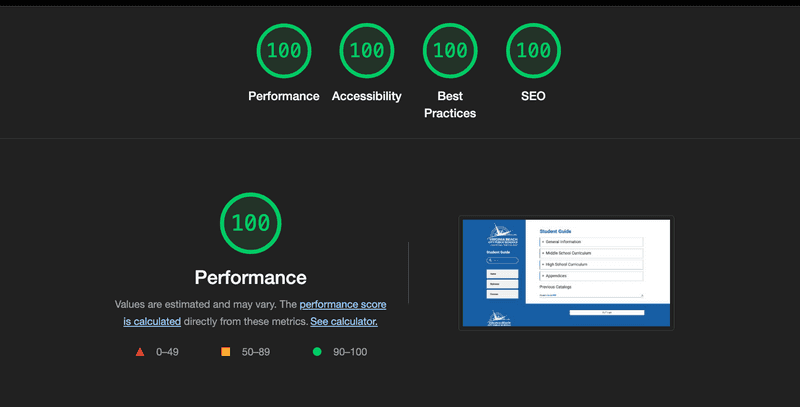Metrics for Measuring Catalog Success
August 26, 2021
Last updated: February 10, 2022
Most institutions have similar goals for their academic catalogs: improve accessibility, serve as a valuable resource for both students and faculty, and increase visibility within the community. However, it is common for institutions to publish a catalog and then fail to monitor its success. Check out four metrics that will help you keep a pulse on your current catalog’s performance.
Accessibility Audit Results
Built-In Accessibility Audit
All Clean Catalog software is accessible out of the box, but we also provide built in accessibility audits to give an extra layer of assurance.
There are plenty of tools to audit your catalog for accessibility, but for this metric the goal should typically be zero accessibility errors to ensure full compliance. Monitoring your catalog's accessibility — for both the digital and PDF versions — can ensure you're meeting accreditation and compliance requirements every year.
Site Usage Data
Clean Catalog let you use Google Analytics or similar tools to gather usage data on your site, and it can provide insight into two of the most valuable metrics for your catalog: are people using it, and how are they using it?
 Page views for a community college catalog. Note the spike during course registration.
Page views for a community college catalog. Note the spike during course registration.
The amount of website traffic your catalog receives is one of the best indications of your catalog’s overall performance. To monitor this metric, you can create a free Google Analytics account to track daily, monthly, and yearly website traffic to your digital catalog. Low monthly website traffic shows that students and faculty are not using your catalog and are instead turning to other resources. This red flag typically means your catalog is not user-friendly, lacks important information, or has limited accessibility.
Similarly, more advanced metrics like how many pages a user visits can offer insight into whether people are able to navigate your catalog and find the information they're looking for. Typically a student using your catalog for registration purposes, or a prospective student checking out your offerings should visit at least 2-3 pages, not just your catalog homepage.
Mobile-Friendliness Test
For most of our clients, after they launch a mobile-friendly catalog with us they get more than 50% of their traffic on mobile devices: a responsive site design is crucial for any digital catalog. Students and faculty will be accessing your catalog site across a myriad of devices with different screen sizes, whether it be a desktop, laptop, cell phone, or tablet.
Your site design should flex to fit the dimensions of every screen size without becoming distorted or inaccessible. You can use this responsive website design checker tool to see how your catalog site looks across different devices.
For a more technical view, you can use Google Lighthouse to highlight any responsive design issues — and get an audit of page-load times and accessibility as well.
 Google Lighthouse audit of a catalog built with Clean Catalog.
Google Lighthouse audit of a catalog built with Clean Catalog.
Search Engine Ranking
Where your institution falls on the list of search engine results is a great indication of whether your digital catalog adheres to modern web standards. Ranking highly is desirable because it increases your institution’s visibility within the community and makes it easy for prospective students to find your course offerings online. Falling low on the list may be a result of slow load speeds, lack of responsive site design, or poor optimization on the backend of your site.
 A Google search for "Welding Degree Kauai" shows their Clean Catalog catalog page as the first result.
A Google search for "Welding Degree Kauai" shows their Clean Catalog catalog page as the first result.
When you search Google for “accounting courses near me” where does your institution fall on the list of search results? Ideally, your institution should be ranked as the top result. Ideally, your main campus website information will be the first result, but having a secondary result beneath that from your catalog can help ensure that prospective students find the information they're looking for.
If your current catalog is falling short on any of these four metrics, it commonly reveals flaws in the backend of your digital catalog. If you’d like to talk with a Clean Catalog team member about the performance of your current catalog and areas for improvement, feel free to reach out to us.
